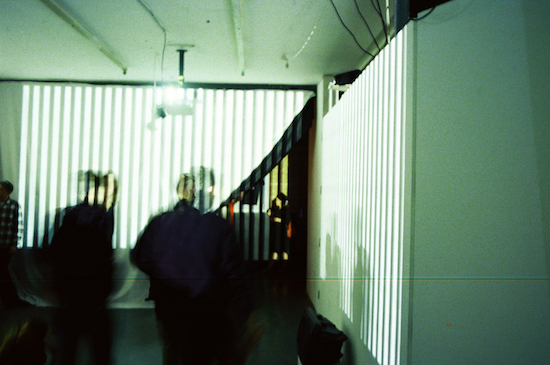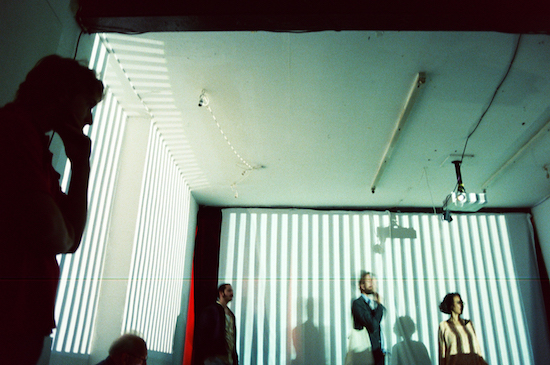Photos: Michael Sangster
Dalston’s DOOMED Gallery is dead. Owners Ken Flaherty and Matt Martin have curated the final exhibitions, they have taken place and the doors are closed.
Doomed operated from 2012 to 2018 as a resistance to the mainstream contemporary art world. It was an attempt to reform gallery space, it was somewhere to go as an artist who didn’t want to (or couldn’t) meet the expectations of typical galleries – it was a place for a community.
DOOMED’s closure is not the typical story of an East London art space being pushed out by rising rents. Instead, the artist-owners have chosen to call time in favour of new projects. Into these new projects, they continue onward with the ethos of DOOMED – providing new and inventive ways for people on the fringes of contemporary art to participate and form communities.
Let’s start off with a quick introduction to the space
KEN FLAHERTY: it started about 6 years ago as a bit of an experiment. I was using it as photographic studio, working as a retoucher. I wanted to do something within photography as a way of redeeming myself from the commercial world I was inhabiting. It was going to be all abstract photography, a little bit pretentious – I got sick of that, there wasn’t enough good quality work around.
We were fumbling, working with just analog, trying different things. I wanted to expand, then met a friend of Matt who mentioned he wanted to do a show.
He was living in Brighton at the time. He did a couple of shows and we got on well, so he eventually moved in – which lasted about a year. We’ve been working together ever since. There’s thirty years between us so we have quite a nice balance of different types of work coming to the gallery. We’re democratic, we don’t have a set style. We like to keep it approachable, anyone who has a nice idea could approach us to do a show.
That was part of your mission statement, wasn’t it? To provide space for people who otherwise may not be able to get it due to financial constraints or the content of their work?
You’ve hit the nail on the head. People who otherwise may not have had shows have been able to have shows here.
This final project here [Xerox and Destroy] has been going on for years. Where did it originate?
MATT MARTIN: This started in 2011. I was running a gallery in Brighton and doing little DIY shows. I was trying to do exhibitions that were affordable for young people or for people who don’t have much money. When I began working with Ken, we both had the same ethos. Like with the photocopy club, the whole idea was to make an affordable exhibition project. All you need is access to a photocopier. it costs 10p to make a print.
Bringing that style of working into a continuous gallery system gave a lot of young photographers the opportunity to exhibit. Work doesn’t have to have frames. It doesn’t have to be perfectly printed. It’s about exhibiting the photos – it doesn’t have to have a big budget.
KF: To That degree, we developed by encouraging people to create themes to accompany the shows. In some respects, people recoup the money they spend on producing the exhibition. People might not necessarily sell prints but they are a lot more likely to sell a zine. It provides a space for them to do that.
Doing a publishing project like a zine can be a great way to develop ideas. Giving artists a physical space to show the work and sell it was probably the push many young artists needed to actually get their work out there.
KF: That brings us to the question of why have an exhibition at all? When you create an exhibition or you publish a zine, you finish with it. You can move on. Your development is intensified as a result of that.
Was that your reason for establishing a gallery?
KF: It was the realisation that you can actually have a gallery anywhere. I used to go to a lot of galleries. To be quite honest with you, I never really enjoyed it. I found it really boring. It never did anything for me, I got sick of it. One thing I did realise was that you can literally have a gallery anywhere. I saw this gallery in someone’s hallway in Shoreditch and it worked really well. I was sitting here amongst all the scrap. In a warehouse space the walls eventually crowd in on you. I was surrounded by motorbikes and jukeboxes and boxes of stuff and I realised – I’ve got this space here. “I’ve got a front door, fuck it”. So I opened the gallery. The feng shui fits quite well, although sometimes people do get a bit scared.
MM: We don’t have a front window, it’s just the gate.

KF: We overheard some people the other day say, halfway down the steps “This is the point where we get murdered”
Is that the atmosphere you’re trying to cultivate?
MM: I remembered when I was a kid in Exeter, there was a club called the Cavern Club. The stairs just came off the street and into nothingness. I remember being stood outside it at fourteen or fifteen with all of my friends saying “you go in first! No, you go in first!”. I like that it has that sense of doom or foreboding.
It does feel like that, it feels like a subcultural space, like somewhere you find out about rather than being in the wider public view.
KF: Grassroots, to me, reflects a physical space. In terms of community – having somewhere to come and meet people – it’s been great seeing people from different groups come here and connect. I don’t know where the scene is, if not online. The unique thing for us is to make the gallery feel like a social space. I’m very proud of that. That’s the gallery I want to go to
In previous interviews, you’ve discussed ‘the institution’ and education. With Doomed, you’ve tried to reform the idea of a gallery. Do you have any more plans in the same vein?
KF: That’s something very close to my heart. I was doing an MA at a point when traditional contemporary galleries were really beginning to kick off. I realised that the system was fucked. We were paying all of this money to be educated in a framework created by factories. They’re not creative spaces; they’re there to make money. I felt that I saw that very clearly.
Going to college, then back to the gallery and realising that this was the place that first made me feel like I had to go to college is what made me realise we needed reform. I realised I didn’t have to go to college – that nobody does. That we don’t need to spend 40k, that there is no job out there for them. That we need to trust each other.
We did cultural studies here, partnered with the University of East London – that was effectively all of the content of my course – for free in the gallery. In my mind, we brought the university to the gallery and we got them to do it all for nothing.
We sometimes have students come and talk to us about the gallery, they often feel very compliant. I’d like to see a bit more rebellion, a bit more spark and a bit more fight.
Is that in your future? Do you have plans to establish something?
I’d like to. I’d like to do something along those lines. I suppose what I miss is revolution. I grew up through the mods and the rockers and the hippies and the punks – everything. I feel like it has plateaued out. I don’t see many people kicking against the system. I’d like to do some kicking.
Doomed Gallery has closed down. For news on future projects from Ken Flaherty and Matt Martin watch this space


